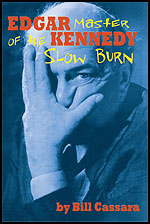 |
 |

|
Prologue
Ned Comstock, the film archivist at the Doheny Library at the University of Southern California, answered the phone. The call was yet another person who wanted to write a book on an old Hollywood movie star. “Who are you writing about?” Ned asked. Without any further introduction, I confidently spoke the name of Edgar Kennedy.
 There was a pregnant pause of about three seconds. This was not the rounding up of the usual suspects of controversial celebrities: Clark Gable, Charlie Chaplin, Marilyn Monroe, Jean Harlow, Fatty Arbuckle and their ilk. Ned curiously replied, “ ...Why Edgar Kennedy?”
There was a pregnant pause of about three seconds. This was not the rounding up of the usual suspects of controversial celebrities: Clark Gable, Charlie Chaplin, Marilyn Monroe, Jean Harlow, Fatty Arbuckle and their ilk. Ned curiously replied, “ ...Why Edgar Kennedy?”
Why Edgar Kennedy, indeed. Edgar died at the top of his game back in 1948, but, since then, Hollywood has barely bothered reflecting on one of its film pioneers. Biographical information about his long and bumpy road to success has always been scarce and has been generally limited to his films.
 Edgar Kennedy appeared in more than 400 films spanning four decades. He was one of the first to be honored (posthumously) with a star enshrining his name on the “Hollywood Walk of Fame.” Known as “The Master of the Slow Burn,” he had many other monikers over the years: “Mr. Average Man,” “Kennedy the Cop,” “Uncle Edgar,” “One Punch Kennedy,” and even “The Human Donald Duck.”
Edgar Kennedy appeared in more than 400 films spanning four decades. He was one of the first to be honored (posthumously) with a star enshrining his name on the “Hollywood Walk of Fame.” Known as “The Master of the Slow Burn,” he had many other monikers over the years: “Mr. Average Man,” “Kennedy the Cop,” “Uncle Edgar,” “One Punch Kennedy,” and even “The Human Donald Duck.”
An original Keystone Kop, Edgar predated the arrival of Charlie Chaplin and Fatty Arbuckle in the Keystone Comedies for Mack Sennett. He played foil to Laurel and Hardy, the Marx Brothers, W.C. Fields, Eddie Cantor and Harold Lloyd. Edgar also played memorable characters in prestigious Hollywood films, working with Clark Gable, Carole Lombard, Jimmy Stewart, Claudette Colbert, Dick Powell and John Wayne. He saw the rise of Frank Capra, Jean Harlow, Betty Grable, Ginger Rogers, Lucille Ball and Doris Day.
 Edgar starred in his own short comedy series for RKO, which spanned seventeen years. These “Average Man” short comedies established films’ first all-talking situation comedy series. They fathered a genre emulated by radio program “families” and later television sitcoms.
Edgar starred in his own short comedy series for RKO, which spanned seventeen years. These “Average Man” short comedies established films’ first all-talking situation comedy series. They fathered a genre emulated by radio program “families” and later television sitcoms.
A screen clown for most of his career, with some notable exceptions, Edgar also directed many comedies himself. After years of anonymity, he finally hit pay dirt by developing a character that was much put upon by others. He would seemingly simmer in frustration over life’s annoyances, determined not to let it bother him. As the tension would mount, Edgar’s pent-up impatience often boiled over. Unable to hold it in, he might finally ignite in anger, resigning himself to fate by emphatically wiping his face with his left hand. His stock-in-trade grimace and “Slow-Burn” made him one of the movies’ most recognizable faces, until death claimed him at the peak of his career at age fifty-eight.
Now, more than half a century after Edgar Kennedy’s death, the embers of interest in his life have been rekindled. Rare family photographs and stories, provided by Edgar’s only daughter, have been shared with the author. Archival research has revealed never-known details about his childhood, professional boxing career and the evolution of his film legacy.
Edgar Livingston Kennedy never had the opportunity to tell his life memoirs, but, with the cooperation of his family, combined with gumshoe efforts, the story can now be shared.
 |
This web page contains the text from the Prologue of Copyright © 2006-2008 Bill Cassara. Order the book from Bear Manor Media. Home | Prologue | Introduction | Notes |